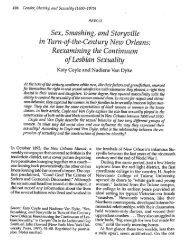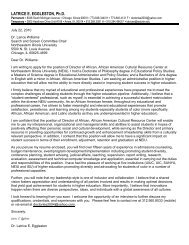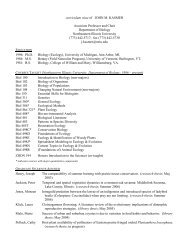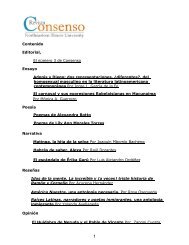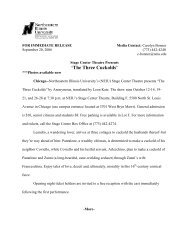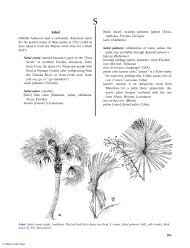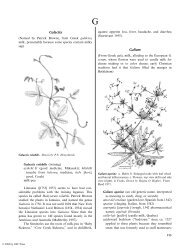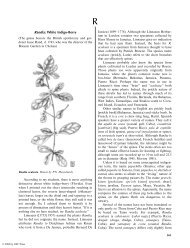Herba Cana - Northeastern Illinois University
Herba Cana - Northeastern Illinois University
Herba Cana - Northeastern Illinois University
Create successful ePaper yourself
Turn your PDF publications into a flip-book with our unique Google optimized e-Paper software.
© 2004 by CRC Press<br />
The Ethnobotany 551<br />
to Diggs et al. (1999) the plants contain a poisonous<br />
saponin that causes photodermatitis.<br />
Fruits have been substituted for hops in making<br />
beer since at least 1868 when Asa Gray recorded that<br />
use (Hedrick 1919, Vines 1977).<br />
Pteridium<br />
(J.A. Scopoli, an Austrian physician and professor of<br />
natural history in Pavia, named the fern with Greek<br />
pteridion, small fern, a diminutive of pteris)<br />
Pteridium aquilinum. Drawn by P.N. Honychurch.<br />
Pteridium aquilinum (of an eagle, from the wingshaped<br />
fronds or leaves)<br />
achshikímiinshi [achsh’kíwmiinshi] (ach, abundant,<br />
sh’kíw, urinate, miinshi, tree, Delaware)<br />
Adlerfarn (eagle fern, German); eagle fern; fougère<br />
d’aigle [fougère de aigles] (eagle fern, Quebec);<br />
helecho de aguilo (eagle fern, Colombia)<br />
[southern] bracken (perhaps from Scandinavia,<br />
akin to Old Swedish braekne, fern, USA,<br />
Bahamas)<br />
[hog, pasture]-brake (from Old German, brache,<br />
‘‘wasted’’ [i.e., wild] land)<br />
faytí:yâ:bî [faitiyabi] (turkey leg replica, Mikasuki);<br />
pinilio:mâ (penwv, turkey, ele, leg, ome,<br />
resembling, Creek); fi:tiyyí (fi:tó, turkey, iyyí,<br />
foot, Koasati); tapitapí (an archaic name, Koasati)<br />
fiddleheads [fiddlenecks] (the young fronds resemble<br />
the head of a violin, in use by 1599)<br />
fourchette (table fork or breast bone, Haiti)<br />
grande fougère (big fern, Quebec); helecho (fern,<br />
Panama, Belize)<br />
poor man’s soap (Alabama)<br />
raineach-mhór [rainich móire] (Mary’s fern, Gaelic)<br />
Although Moerman (1998) and Balick et al. (2000)<br />
separate Pteridium aquilinum var. caudatum into<br />
Pteridium caudatum, Wunderlin (1998) retains both<br />
as a single species. Regardless, P. aquilinum is widespread<br />
and was used by people from Alaska to Mexico<br />
and Florida. Among the relatives of Florida people,<br />
the Koasati made a decoction of the roots for chest<br />
pain (Taylor 1940). The Seminoles used the plant for<br />
‘‘Turkey Sickness’’ (permanently bent toes and fingers)<br />
(Sturtevant 1955). Murphee (1965) found people in the<br />
Panhandle making a tea from the plants to treat burns.<br />
Farther north, the steamed mature fronds are used<br />
to make medicinal teas and inhalants for lung<br />
disorders and headaches (Moerman 1998). The young<br />
buds (fiddleheads) are edible. Older parts are poisonous<br />
(Morton 1968b), and King (1984) warns against<br />
using it for food at any stage. Yellow and green dyes<br />
are extracted from the roots (King 1984, Tull 1999).<br />
Pterocaulon: Blackroot<br />
(From Greek pteron, wing, plus kaulos, stem)<br />
Within the United States, there are relatively few<br />
plants whose roots yield a black sap. The two in the<br />
southeast are called ‘‘blackroot.’’ Scientifically, the<br />
herbs belong to the genus Pterocaulon. The green<br />
leaves with their white undersides merging into the<br />
stem and extending downward toward the ground, like<br />
wings, are as characteristic as their black roots. The<br />
first information Europeans had of these plants was<br />
when Linnaeus called them Gnaphalium virgatum in<br />
1759. However, it was Stephen Elliott, an American<br />
professor in Charleston, South Carolina, who gave<br />
them the Greek name fitting their morphology in<br />
1823.<br />
For many years, it was believed that a single<br />
species grew in the United States, and it was called<br />
P. virgatum. Then, when the Frenchman André<br />
Michaux, who explored the Carolinas and Florida,





